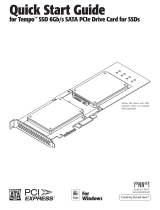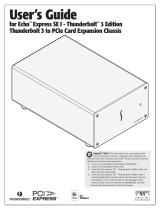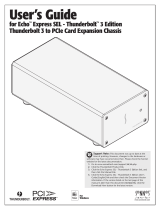Page is loading ...

Quick Start Guide
for Tempo
™
SSD PCIe
®
Card
Fo
r
Windows
Tempo SSD PCIe Card shown
with SSDs attached; drives not
included (sold separately)
Support Note: This document was up to date at
the time of printing. However, changes to the
hardware or software may have occurred since then. Please
check the Sonnet website for the latest documentation.
1. Go to https://www.sonnettech.com/support/kb/kb.php
2. Navigate to and click the Tempo SSD PCIe Card link.
3. Click the Manual link.
4. Click the Tempo SSD PCIe Card Quick Start Guide
[English] link and then check the Document Version
information. If the version listed on the last page of this
manual is later than this document (revision D), click
the Download Now button for the latest version.

2
Introduction and Package Contents
Congratulations on your purchase! Tempo SSD PCIe Card provides
a handy way to install one or two 2.5-inch SATA SSDs (or HDDs)
into a PCIe slot. Its unique design enables it to be used in half-
length card spaces (with a single drive) or full-length card space
with two drives when you attach the included extension bracket.
macOS
®
/OS X
®
, Windows
®,
and Thunderbolt
™
compatible,
this card supports both operating systems’ RAID features and
works in Thunderbolt-to-PCIe card expansion chassis without
additional drivers
1 – Tempo SSD PCIe Card
This half-length card supports one SSD on its own. Support
for a second SSD requires the installation of the included
extension plate.
2 – Drive Mount Screws
When you use a single SSD, this set of four screws secures
your SSD to the Tempo SSD card. When you use two SSDs,
this set of four screws secures the extension plate to the
Tempo SSD card.
3 – Extension Plate and Mounting Screws
This plate must be attached to the Tempo SSD PCIe card
when you install a second SSD. The plate extends the total
length of the assembly to that of a full-length PCIe card to
enable it to use a computer’s or expansion chassis’ card guide.
Attach the plate to the card using the included package of
four screws; attach both SSDs using the eight mounting
screws attached to the plate.

3
Installation Preparation
Prior to attaching SSDs to the Tempo SSD PCIe
Card and installing the assembly, you should
perform the steps below as necessary. Remove
the Sonnet card from its packaging, handling
the card by its edges and without touching any
components or gold connector pins. Set the card
down on a flat, level surface to perform the steps.
Extension Plate Installation Steps
If you intend to install a second SSD, you must
first attach the extension plate to the Tempo SSD
PCIe Card. Otherwise, skip to the next page.
1. Flip the Sonnet card component side down
(Figure 1).
2. Line up the extension plate underneath the
card as shown (Figure 1).
3. Using the included package of four screws,
secure the extension plate to the card; do not
overtighten the screws (Figure 1).
4. Skip to page 5, Dual SSD Intallation Steps.
Optional Card Preparation Steps
Figure 1

4
SSD Installation Steps
Single SSD Installation Steps
If you intend to install two SSDs, skip to the next
page. Otherwise, perform the steps below.
1. If you haven’t already done so, remove the
Tempo SSD PCIe Card from its packaging,
handling the card by its edges and without
touching any components or gold connector
pins. Set the card down on a flat, level surface
(Figure 2).
2. Remove the SSD from its packaging.
3. Place the SSD label side up on top of the
Sonnet card with the SSD’s and card’s
connectors aligned with each other
(Figure 2).
4. Push the SSD’s connector into the card’s
connector until the SSD is completely seated
(Figure 2).
5. Holding the SSD firmly against the card, flip
the assembly over.
6. Using the included package of four screws,
secure the SSD to the Sonnet card; do not
overtighten the screws (Figure 3).
7. Skip to page 7, Tempo SSD PCIe Card
Installation Steps.
Figure 2
Figure 3

5
SSD Installation Steps
Dual SSD Installation Steps
1. Remove and set aside the eight screws secured
to the extension plate (Figure 4).
2. Flip the card/plate assembly over, component
side up.
3. Remove the SSDs from their packaging.
4. Place an SSD label side up on top of the
Sonnet card with the SSD’s and card’s
connectors aligned with each other
(Figure 5).
5. Push the SSD’s connector into the card’s
connector until the SSD is completely seated
(Figure 5).
6. Holding the SSD firmly against the card, flip
the assembly over again.
7. Using four of the eight screws you removed
previously, secure the SSD to the card; do not
overtighten the screws (Figure 6).
Figure 5
Figure 6
Figure 4

6
SSD Installation Steps
Dual SSD Installation Steps (continued)
8. Flip the card/plate assembly over again, and
then place the second SSD label side up on
top of the extension plate with the SSD’s and
card’s connectors aligned with each other
(Figure 7).
9. Push the SSD’s connector into the card’s
connector until the SSD is completely seated
(Figure 7).
10. Holding the SSD firmly against the plate, flip
the assembly over again.
11. Using the remaining four screws you
removed previously, secure the SSD to the
extension plate; do not overtighten the screws
(Figure 8).
Figure 7
Figure 8

Tempo SSD PCIe Card Installation Steps
Driver Information
macOS/OS X:
The drivers that enable the Tempo SSD PCIe Card to work in your
computer are installed as part of the Mac operating system; the
Tempo card is ready to use when you power on your computer.
Windows:
After starting up Windows, the drivers that enable the
Tempo SSD PCIe Card to operate in your system are installed
automatically. A Found New Hardware popup will appear. Then,
information regarding the process of identifying the card, and
searching for and installing the appropriate software will appear.
Finally, the message “Your new hardware is installed and ready to
use” will be displayed, and then the popup will disappear.
Formatting Drives
macOS/OS X:
Use Disk Utility (found in the Utilities folder within the
Applications folder) to set up connected SSDs for use.
Windows:
If you intend to format drives connected to the Tempo card using
Windows drive formatting tools (Disk Management), you may
locate the information by using “format volume”, and “create
striped volume” as search items in Windows Help.
Booting From Attached SSDs
macOS/OS X:
Tempo SSD supports booting OS X 10.6.8–macOS 10.12.6
from attached SSDs, including those configured as a RAID set,
when installed in early 2008 and later Mac Pro computers and
Thunderbolt-to-PCIe expansion chassis, as described below:
• All Tempo SSD PCIe cards support booting from attached SSDs
when the card is installed in a Thunderbolt-to-PCIe expansion
chassis.
• Installed in a Mac Pro (Early 2008 and newer models), revision B
(serial number starts with B) and later cards support booting out
of the box.
• Revision A cards may be updated to support booting when the
card is installed in a Mac Pro (Early 2008 and newer models).
You may obtain the software to update the card by visiting
https://www.sonnettech.com/support/kb/kb.php, navigating to
the Tempo SSD PCIe Card support page, and downloading the
firmware updater.
Please note that in some cases it may be necessary for you to hold
the option key during a start or restart, and then select the startup
disk attached to the Tempo card.
Windows:
Tempo PCIe SSD Card supports booting from a single SSD when
the card is installed in a PC running Windows 10, 8 or 7; booting
from a software-created RAID volume is not supported.
Card Installation Steps for All Users
1. Shut down your computer or expansion chassis, disconnect
its power cable, and then open it to access the expansion
card area (PCI Express slots); refer to the user manual for
specific information
2. Locate an available PCI Express slot and remove its access
cover if necessary. Thunderbolt-to-PCIe card expansion
system users and Windows users skip to the next step; Mac
Pro users:
• Mac Pro (2019) Mac Pro (Mid 2012), Mac Pro (Mid 2010),
Mac Pro (Early 2009) and pre-2008 Mac Pro users may
install the card into any available slot; Mac Pro (Early
2008) users should use slot 2 when available for best
performance, or slot 3 or 4 if necessary.
3. Install the Tempo SSD PCIe Card with attached SSD(s) into
the slot; make sure the card is firmly seated and secured.
4. Close your computer or expansion chassis, and then
reconnect the computer’s or expansion chassis’ power cable
and other cables if necessary.
7
Support Note for Pre-2008 Mac Pro Users: When
you turn on your computer after installing the Tempo SSD
PCIe Card depending on which version of Mac OS X your
computer is running, the Expansion Slot Utility application will
open automatically. If it does not open by itself, you must do so
manually (Expansion Slot Utility is located in the /System/Library/
CoreServices folder). Select the configuration appropriate for
your setup (Tempo SSD PCIe Card is an x2 card, and should be
assigned at least an x2 slot), and then click Quit if the default
configuration was appropriate, or click Save and Restart if you
changed the configuration.
Support Note: If you have a Mac Pro 5,1 (Mid 2010 or
2012) computer, you will need to move what Apple refers to
as the “PCIe slider” in order to install the Sonnet card. Simply press
the indicated button and then move the slider to the left. After
installing the card, move the slider back to the right.
PCIe slider
button

Contacting Customer Service
The Sonnet Web site located at www.sonnettech.com has the
most current support information and technical updates. Before
contacting Customer Service, please check our Web site for the
latest updates and online support files, and check this Quick Start
Guide for helpful information.
Email support requests generally receive the fastest responses, and
are usually processed within a 24-hour period during normal
business hours, excluding holidays. When you contact Customer
Service, have the following information available so the customer
service staff can better assist you:
• Product name
• SSD model(s)
• Computer model
• OS version
• A System Report (macOS), or a Microsoft System Information
MSINFO32 (Windows) report (Windows), along with a
description of the issue(s) you are encountering with your device
If further assistance is needed, please contact Sonnet Customer
Service at:
E-mail: support@sonnettech.com
Tel: 1-949-472-2772
(Monday–Friday, 9 a.m.–5 p.m. Pacific Time, excluding holidays)
Japan Customers
Contact Sonnet Customer Service Japan at:
E-mail: [email protected]
Support Information
©2020 Sonnet Technologies, Inc. All rights reserved. Sonnet, the Sonnet logotype, Echo, Tempo, and xMac are trademarks of Sonnet Technologies, Inc. Mac, the Mac logo,
macOS, Mac Pro, and OS X are trademarks of Apple Inc., registered in the United States and other countries. Thunderbolt and the Thunderbolt logo are trademarks of Intel
Corporation in the U.S. and/or other countries. Other product names are trademarks of their respective owners. Product specifications subject to change without notice.
QS-TSATA6-SSD-E2-E-D-101320
/





